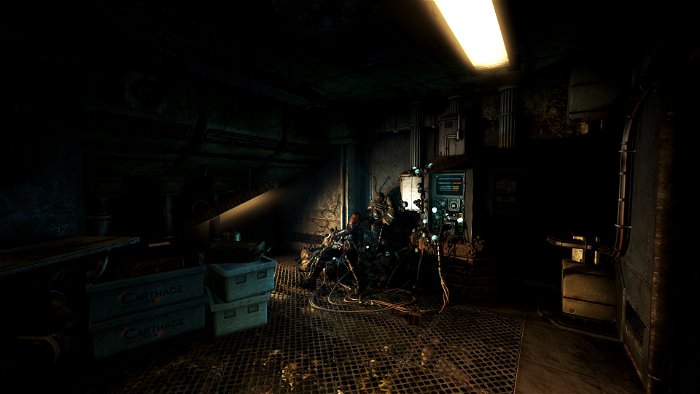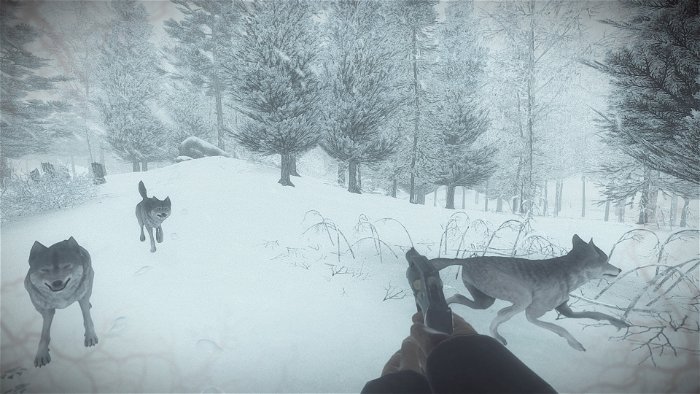Of all the video game genres, perhaps the hardest to pull off is horror. More than almost any other genre, horror requires the player to meet the game halfway—to be willing to be frightened and once this atmosphere of terror is created, it is incredibly fragile.
But how do horror game designers successfully create and maintain an atmosphere of suspense and fear? How do they make their games scary? And, most of all, how do they avoid accidentally shattering the atmosphere they have created through poor gameplay design decisions?
Creating Atmosphere
One of the first challenges faced by a horror game developer is to create an atmosphere of fear and dread. This can be particularly difficult when it comes to a video game.
“Games have an unusual challenge in trying to be scary,” says Adam Hines, developer of Oxenfree. “Almost every video game ever released on this planet has the constant threat of death hanging just over your head at any and all times. With horror games, you have to ‘reset’ the audience a little, and make them feel like the penalties of losing or performing poorly has much greater stakes than just having to hit ‘Continue’ again.”
To accomplish this in Oxenfree, Hines and Night School Studio relied on foreshadowing, with characters mentioning that the island is deserted, that they will be stranded there until morning, and talking about grisly deaths that had happened there—all of which lays a subconscious groundwork that pays off when the characters open a portal to another dimension, setting the horror in motion.
Foreshadowing is not the only way to create atmosphere. In Frictional Games’ SOMA, the player character closes their eyes during an experimental brain scan, only to wake up facing a desperate struggle for survival in an underwater world where some sort of apocalypse has happened.

“I think the most important aspect is to leave gaps, and to set a mood where the player fills those gaps with various horrifying things,” says Thomas Grip, one of the developers of SOMA. However, as Grip notes, one cannot just rely on a single element such as fog or poor visibility. “It is when other elements [such as lore, music, weird sighting[s], etc] push the player’s imagination in the right direction that things become scary. On top of that, you also want the player to feel vulnerable and to make sure the gameplay is simple enough so that player has lots of mental capacity left for being paranoid.”
The use of mystery is very effective at creating horror, particularly when alongside it the normal video game mechanic of giving the player control is reversed to make them feel vulnerable. In Verde Station – a game where the player character is alone on a space station and slowly goes insane from paranoia, developer Soren Silkenson avoided traditional horror elements like jump scares, relying instead on mystery and psychological horror.
“The main point of the game is to figure out what’s going on around you,” says Silkenson. “As you find more information you also come across more questions. I force the player into situations where they don’t have all the information they need which, hopefully, puts them on edge because if they don’t know what’s going on they don’t know what to expect next.”
Staying Out of the Player’s Way
Once the atmosphere of horror has been created, it has to be maintained. Many horror games make the mistake of shattering it through gameplay, adding puzzles that are disconnected from the story or amount to little more than busy work, pulling the player out of the game in the process. Ensuring that the player is left in a state of tension and fear is therefore as much about knowing what not to do as it is about knowing what to do.
In Parabole’s Kona, a suspense game set in Northern Quebec during the 1970s where the player has to investigate the mysterious disappearance of the population of a small village, one of the top design priorities was to use the pacing of gameplay to keep players engaged—and this meant avoiding breaking immersion by accident in its puzzles.

“If you add puzzles that are too easy, players will move faster, which will break the pace you were aiming at when developing the game,” says Parabole’s Jean-François Fiset. “On the other hand, if you make them difficult enough (and also realistic), they will feel like they are in the game, solving them on their own. This way, even if they move around quickly, the overall pace won’t be affected.”
In Oxenfree, a great deal of thought went into using player psychology to avoid breaking immersion. The key to this was ensuring that players felt close to the main characters, and this involved ensuring that the gameplay and the story joined in a natural fashion.
“The trick is to not fight against the player’s natural state of mind, but actually use it to your advantage,” says Oxenfree’s Adam Hines. “For example, every player when playing a brand new game will test their boundaries a little, and be a little confused as they learn the buttons and what’s expected (and demanded) of them. So, make sure the opening scene puts the main characters in a setting where that kind of behaviour [testing boundaries] and mindset [light confusion] makes sense.”
Part of making this work involves understanding that the game developer has little control over the player when it comes to telling the story—and trusting the player to meet them halfway.
“You have to give the player a little space,” says Verde Station’s Soren Silkenson. “If you’re simply forcing them down a path and creating scary moments it can work, but it’s not always effective for long. If you give the player room to decide for themselves how to proceed they become more engaged. If they decide to go down the dark, grungy hallway they have to accept the consequences. If they have no choice, you might as well be making a scary movie, not a game. It’s difficult to balance that freedom with making sure the game moves forward.”
One of the problems with getting the balance between gameplay and story wrong is that it can leave the player concentrating on the wrong thing, as SOMA’s Thomas Grip notes.
“If you rely too much on complicated gameplay to drive engagement, the player will only be focused on that, and not get into the right paranoid state,” says Grip. “I don’t mean the game should be filled with cut scenes or tons of notes to read though. What you want is to dress the gameplay in lots of narrative context and to design interesting situations for the player to be in.”
It is also vital to remember that because it is a video game, rather than a movie or a book, it has to be designed as one. Not only will the players have agency of their own, but how they experience the game will have nuances that must be taken into account to avoid breaking immersion.
“Anything that requires specific timing can’t really be done, at least in the pure sense of the moment actually being playable,” says Adam Hines. “In Exorcist III, there’s a now classic scene where someone gets their head cut off after an agonizingly tense, sustained long shot of a nurse checking rooms in a hospital. And in The Conjuring 2, there’s a moment where Lorraine Warren suspects a painting in a dark room is actually the demon that’s been haunting them. These sequences are brilliantly planned down to the frame, and you just can’t depend on players to stand and look exactly when and where they should to make stuff like this work, not without cheating and just playing a cut scene, at least.”

This fragility when it comes to maintaining atmosphere even extends to fail states, where a single miscalculation can destroy the work of the entire game leading up to that point.
“[Some]thing to avoid is the player repeating sections over and over,” says Thomas Grip. “You need to be very careful about what happens if the player fails at something. That doesn’t mean the game should be devoid of fail-states, but that you need to take extra care in crafting them.”
But perhaps the most important part of ensuring that a horror game works is to get extra eyes on it. Part of the success of any horror game is the unknown and the surprise it creates—something that the designer of the game will never be able to experience with it. This can make the play testing experience of the developers very different from that of the players experiencing it for the first time.
“You may have created a great scenario for the player but it can fall flat if it’s not presented in a way that fits with what the player was just doing,” says Verde Station’s Soren Silkenson. “Playtesting can help immensely with this. I can’t tell you how many parts of my game I changed for the better after allowing someone else to play through it. Fresh eyes always help keep you on track.”




